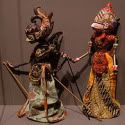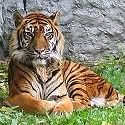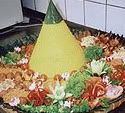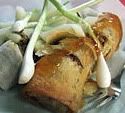
Batik
 Batik is a wax-resist dyeing technique used on textile. Due to modern advances in the textile industry the term has also been used for fabrics which incorporates the traditional batik patterns although not necessarily produced using the batik techniques. Silk batik is especially popular.
Batik is a wax-resist dyeing technique used on textile. Due to modern advances in the textile industry the term has also been used for fabrics which incorporates the traditional batik patterns although not necessarily produced using the batik techniques. Silk batik is especially popular.Javanese traditional batik, especially from Jogjakarta, has special meanings which is rooted to the Javanese idea of the universe. Traditional colours include indigo, dark brown ,and white which represents the three major Hindu Gods (Brahma, Visnu,and Siva), and certain patterns can only be worn by royals. Other regions of Indonesia have their own unique patterns which normally take themes from everyday lives. Incorporating patterns such as flowers, animals or people. Batik or fabrics with the traditional batik patterns similar to the Indonesian batik are also found in several countries such as West Africa,Nigeria, Ghana, Cameroon, Uganda and Mali, and in Asia, such as India, Sri Lanka, Bangladesh, Iran, Philippines, Malaysia, Thailand and Burma, which displays the influence of the Indonesian batik internationally.
Etymology
Although the word's origin is Javanese, its etymology may be either from the Javanese amba ('to write') and titik ('dot' or 'point'), or constructed from a hypothetical Proto-Austronesian root *beCík, meaning 'to tattoo' from the use of a needle in the process. The word is first recorded in English in the Encyclopedia Britannica of 1880, in which it is spelt battik. It is attested in Indonesian Archipelago of the Dutch colonial period in the various forms mbatek, mbatik, batek and batik.
Culture
Batik has been both an art and a craft for centuries. In Java, Indonesia, batik is part of an ancient tradition, and some of the finest batik cloth in the world is still made there.
Contemporary batik, while owing much to the past, is markedly different from the more traditional and formal styles. For example, the artist may use etching, discharge dyeing, stencils, different tools for waxing and dyeing, wax recipes with different resist values and work with silk, cotton, wool, leather, paper or even wood and ceramics.
Procedure
Melted wax (Javanese: malam) is applied to cloth before being dipped in dye. It is common for people to use a mixture of beeswax and paraffin wax. The beeswax will hold to the fabric and the paraffin wax will allow cracking, which is a characteristic of batik. Wherever the wax has seeped through the fabric, the dye will not penetrate. Sometimes several colours are used, with a series of dyeing, drying and waxing steps.
Thin wax lines are made with a canting (also spelled tjanting or tjunting), a wooden handled tool with a tiny metal cup with a tiny spout, out of which the wax seeps. Other methods of applying the wax onto the fabric include pouring the liquid wax, painting the wax on with a brush, and applying the hot wax to pre-carved wooden or metal wire block (called a cap or tjap) and stamping the fabric.
After the last dyeing, the fabric is hung up to dry. Then it is dipped in a solvent to dissolve the wax, or ironed between paper towels or newspapers to absorb the wax and reveal the deep rich colors and the fine crinkle lines that give batik its character. This traditional method of batik making is called Batik Tulis (lit: 'Written Batik').
The invention of the copper block or cap developed by the Javanese in the 20th century revolutionized batik production. By block printing the wax onto the fabric, it became possible to make high quality designs and intricate patterns much faster than one could possibly do by hand-painting. This method of using copper block to applied melted wax pattern is called Batik Cap (pronounced like "chop").
Indonesian batik used for clothing normally has an intricate pattern. Traditionally, wider curves were reserved for batik produced for nobles. The traditional cloth has natural colors (tones of indigo and brown) while contemporary pieces have more variety of color.
Javanese batik typically includes symbols. Some decorative pieces may be mystically-influenced, and this type is very rarely used for clothing. Some may carry illustrations of animals or other intricate designs. (source)



















0 comments:
Post a Comment